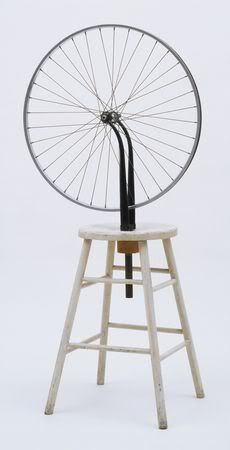Part I Glenn D. Lowry, Director of MoMa, states that the Museum is predicated on the proposition that the art of our time - modern art - is as vital and important as the art of the past. Being one of the high profile modern art galleries in the world, MoMa, per Lowry, has continued in its dual quest of promoting avant-garde, and serving the interests of the public, by attempting to define a canon of modern art.
But the question is, Has a canon of art already been defined to enable MoMa to trim it into a special definition further not only in prospects of time but also of acceptance?
Here's my point for the moment: In one of MoMa's bigger rooms on one of the floors for permanent exhibits is a strange looking assemblage of unstrange objects that will never fail to draw attention from even the most uninterested visitor - an "artwork" by the American
Marcel Duchamp (1887-1968) that had come to be known as the
Bicycle Wheel.

Bicycle Wheel is understandably called that because it is almost exactly that, a bicycle wheel mounted upside down on a kitchen stool, no more nor less, and the issue that resounds heavily on the gabbler of artistic judgment is that which resounds heavily on the gabbler of art: Is this art? (or if we make the question more specific, as if it helps really, Is this modern art?)
The assembler of Bicycle Wheel (on this piece I will not otherwise call Duchamp a creator considering that the components of Bicycle Wheel are pre-exisiting "readymade" objects that are "end" in themselves) had somehow, unwittingly or un, aligned his artistic curiosity with the idea that MoMa had now wanted us to recognize - that modern art implies an institution that is forever willing to court controversy - for Duchamp himself admitted that Bicycle Wheel was his way of challenging the limits of what could be considered as art.
Obviously, MoMa considered Bicycle wheel as art, as Art, as An Important Piece Of Modern Art, by the significant space it was made to occupy on one of the floors reserved for permanent exhibits, made more important by what I remember vaguely as some restraining object (string? space? advisory?) that prevented onlookers from coming very close to touching it and exercising the urge to roll the wheel like you used to do with the roullete in your favorite backyard carnaval. (And if you asked me, that restraining object could have been a yellow police tape that announces the spot, officially, as a crime scene.)
The great Ralph Waldo Emerson, in his essay Art, denotes our own inherent connection to art in this heavenly vein: The traveller who visits the Vatican and passes from chamber to chamber through galleries of statues, vases, sarcophagi and candelabra, through all forms of beauty cut in the richest materials, is in danger of forgetting the simplicity of the principles out of which they all sprung, and that they had their origin from thoughts and laws in his own breast.
Ruminating on Emerson's words, Duchamp's Bicylce Wheel actually gives me a heavy paroxysm on my chest, yet I keep my judgment on probation, so educate me please:
Is Bicycle Wheel, in your own honest artistic opinion, a work of art?
 Bicycle Wheel is understandably called that because it is almost exactly that, a bicycle wheel mounted upside down on a kitchen stool, no more nor less, and the issue that resounds heavily on the gabbler of artistic judgment is that which resounds heavily on the gabbler of art: Is this art? (or if we make the question more specific, as if it helps really, Is this modern art?)
Bicycle Wheel is understandably called that because it is almost exactly that, a bicycle wheel mounted upside down on a kitchen stool, no more nor less, and the issue that resounds heavily on the gabbler of artistic judgment is that which resounds heavily on the gabbler of art: Is this art? (or if we make the question more specific, as if it helps really, Is this modern art?)